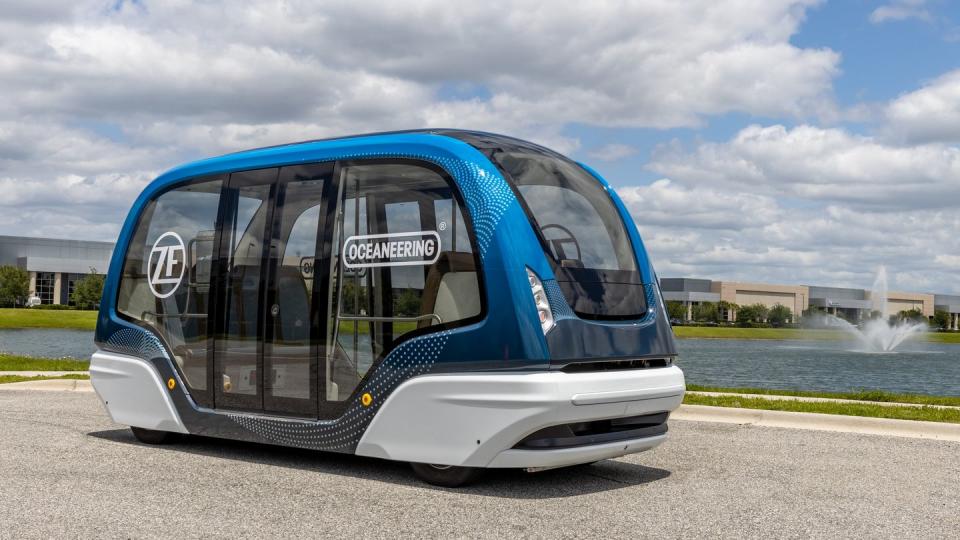There’s a US Production Plan for ZF’s Autonomous Shuttle

German supplier ZF licenses Texas-based Oceaneering International to produce and sell its GRT (Ground Rapid Transport) shuttle in the US.
The GRT shuttle is a Level 4 vehicle, meant primarily for segregated traffic lanes, and is aimed at cities and municipalities to run along a set route, in contrast to Level 4 ride-hailing cars and shuttles.
Several autonomous vehicle developers are now working to launch ride-pooling shuttles that can transport several passengers at once to different destinations.
It's safe to say that we are now in the early stages of the robotaxi revolution, which arrived a few years after it was forecast in the previous decade, and for now remains confined to just a handful of cities. There are certainly a few asterisks to this revolution, but it is being televised.
And in addition to robotaxis meant for just two or three passengers, autonomous developers are also working on driverless shuttle buses that will carry more passengers per trip, with some of them designed to be hailed via an app or follow set routes.
It can seem like the future of buses is electric, autonomous, and also quite a bit smaller than the buses we see in big cities in the US. And the race for autonomous shuttles is getting started as well.
German supplier ZF revealed its GRT (Ground Rapid Transport) vehicle some time ago, offering room for 22 passengers (8 seated and 14 standing), and no space for a driver. Categorized as automated minibuses by the company and developed by ZF subsidiary 2getthere, the GRT is aimed primarily for use in segregated lanes rather than all city roads, such as at airports.
Now, the company reveals just who will build and sell the GRT in the US in the coming years.
ZF has granted a license to Houston-based Oceaneering International to produce and sell several thousand of its GRT shuttles in the US.
The company will offer the shuttle to cities, municipalities, and enterprises for use in segregated lanes, so the shuttle itself will be limited to bus lanes or their equivalents for safety and will run along a set route.
ZF has a head start on a number of other developers, as this is already the third generation of the GRT. Previous versions of the company's GRT system have transported 14 million passengers and have covered 100 million kilometers with its autonomous driving systems.
"For shaping urban mobility of the future, autonomous shuttles are a key answer to reduce traffic, number of vehicles, and emissions," says Alexander Makowski, Senior Vice President-Product Line Autonomous Mobility at ZF.
However, as this is a shuttle system for segregated lanes, the shuttle itself won't mix with real-world traffic and won't pick up passengers just anywhere. This makes it different from shuttles now being developed for ride-hailing tasks for paying customers, and also makes it less suitable for traffic in large cities.
As such, this is a niche within the greater universe of Level 4 buses and shuttles.
The main question with this type of shuttle is whether there will still be enough demand for shuttles with set routes and segregated lanes in the near future, just as much larger Level 4 buses that will mix with city traffic are on the way and are currently being tested in the UK, in addition to other countries.
Medium-sized ride-hailing shuttles and robotaxis are also putting pressure on this subcategory, as companies like Waymo and Cruise seek to fill cities with their driverless vehicles coupled with ride-hailing apps.
ZF's vision of Level 4 autonomy in segregated lanes, therefore, is already somewhat of an older, more confined concept suited well to universities, airport parking lots, and various sprawling expos, but still limited to very ideal or even fenced-off traffic environments. And the number of these ideal environments where other traffic may not even be permitted is finite, especially when robotaxis are mixing with some of the country's most chaotic traffic.
As the robotaxi battle is still defined by Silicon Valley's winner-take-all mentality, there could be enough niches within the Level 4 sphere to permit various companies to focus on different types of vehicles.
So we wouldn't bet against a more limited form of Level 4 passenger travel, even as robotaxi mania is sweeping the West Coast.
Will we see shuttles of this type displace buses in some cities and towns in America this decade, or is this a process that will take longer? Let us know in the comments below.

 Yahoo Autos
Yahoo Autos 